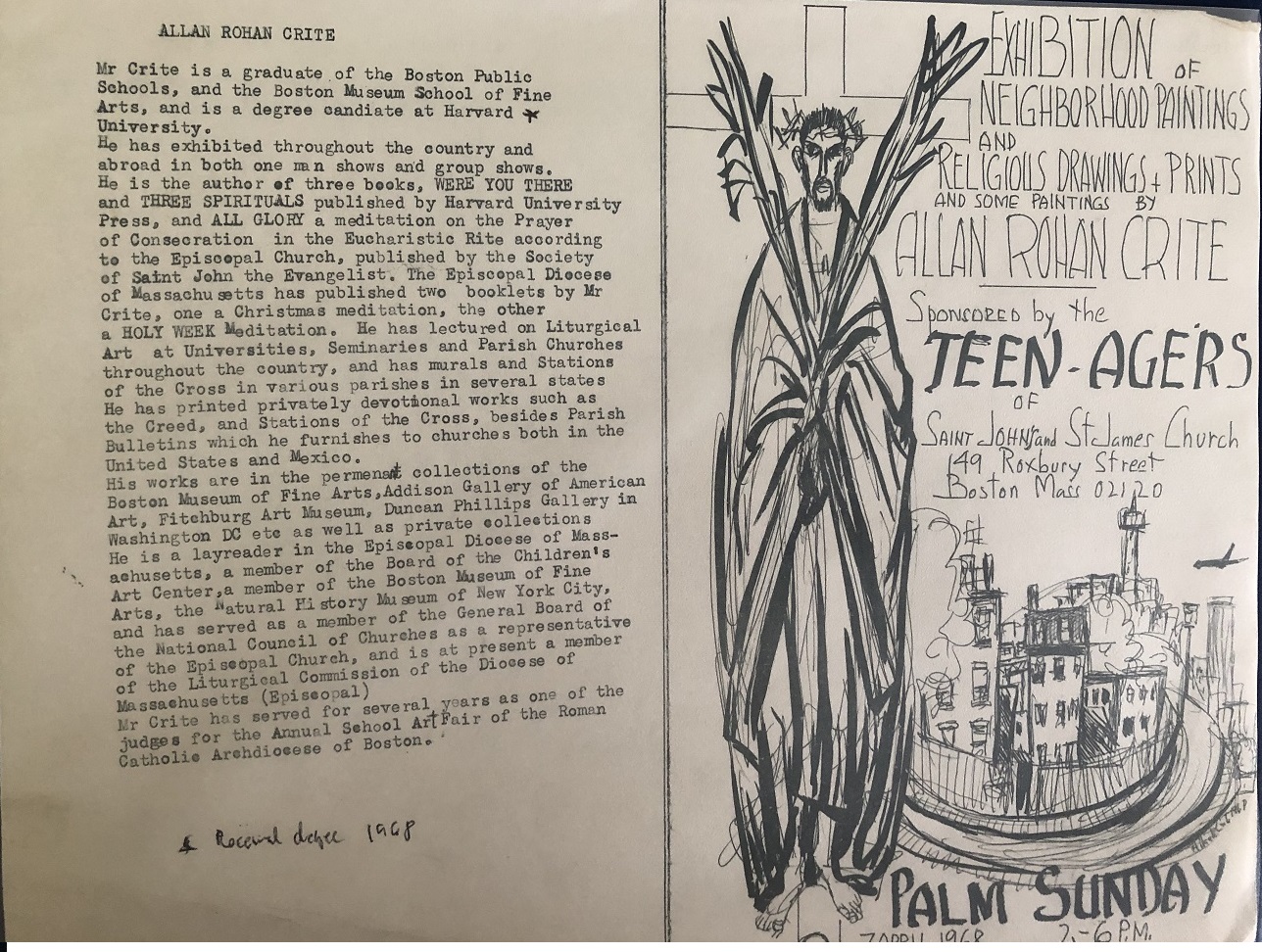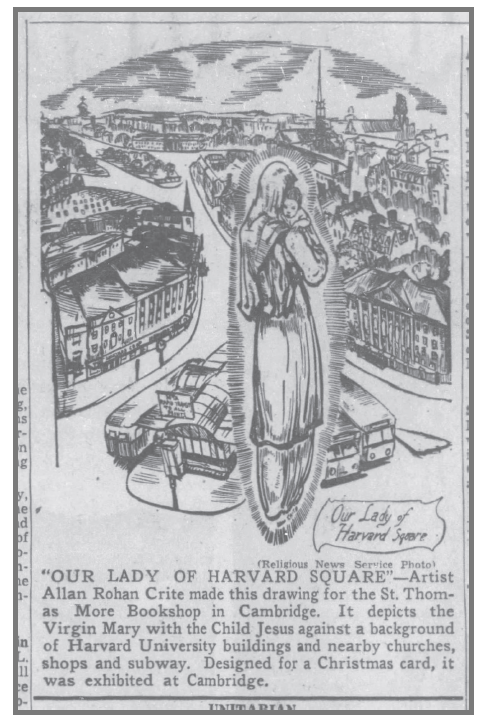Notes for Allan Crite profile
Allan Crite, whose art career spanned [seven] decades, and whose work is showcased in the Smithsonian, the Boston Museum of Fine Arts, the New York Museum of Modern Art, the Boston Athaneum and other noted museums, was also known as a local artist who created the church bulletins that St. John St. James parishioners enjoyed for 30 years.
Crite designed church bulletin covers for churches in several states, featuring everyday people in scenes from the weekly lectionary. Bulletins might feature the story of Mary and Martha, for example, with a contemporary Martha, broom in hand, scolding her sister Mary, while Mary sits adoringly at Jesus's feet in a living room that looks a lot like the living room of a 1970's Boston apartment. Another week's bulletin might feature Jesus with the fishermen Peter, Andrew, James and John, with a scene drawn from Boston's waterfront.
Boston cityscapes, often with an airplane in the background, emphasize the links from biblical stories to the present.
Many bulletins featured scenes from the Virgin Islands, Mexico or other locations, showing Jesus present in each of these locations.
Hand lettering highlighted words from the Lectionary readings, highlighting a few key words from the reading, drawing out a theme that one might not have seen before.
Crite's workspace at St. John's was in a building next door on Tremont, a three decker the Parish had purchased for its programs and usually referred to as St. John's Workshop. It had classrooms, church offices, and an apartment; that's where the Community Information Center was housed. Allan used the space in the rear of the first floor to house his large printing press on which he did the bulletins and other printing; and packaging the bulletins to mail around the country (probably from the Roxbury Crossing P.O. which was close by.) When Allan moved to the South End (from his and his mother's home on Dilworth Street) he had enough space to move the press into that home.
As noted the neighborhood drawings and paintings served and serve as a background for the religious drawings, for in this I am following the ancient tradition of Christian art, in showing the holy events of the Life of Our Lord in comtemporary terms, thus Our Lord carries the Cross through our streets, so in such dipection the present day is identified with Our Lord, for in truth he does carry the Cross in our streets, He does speak to us today and He speaks not as an historical character of 2000 years ago, but to us today. Thus in Gothic paintings of the 14th century Christ is shown in a Gothic village so the people of that period thought of Our Lord in terms of their times and as a result the great strength of the Gothic paintings. So today I am following in the same tradition.
There are two aspects of the Gospel story, one the historic instance and the other the eternal aspects. The Spiritual "Were You There When They Crucified my Lord" brings this out., that all of us are present at the Cross, the Tomb and the Risen Christ, thus in these drawings and prints, Christ is shown against the background of today.
Allan R. Crite



Artist Allan Rohan Crite was keenly aware of the presence of Christ in the world
By RACHELLE LINNER
Allan Rohan Crite, a painter of everyday African-American life and the granddaddy of the Boston arts scene, died Sept. 6 at the age of 97. At his funeral in Boston's Trinity Church, the Rev. Edward Rodman, a professor at the Episcopal Divinity School in Cambridge, eulogized Mr. Crite as a "lay theologian." It is a particularly apt description of this generous, gentle and gracious artist whose works are suffused with a profound incarnational sensibility and informed by a vocabulary of worship that draws from the sacramental life of the Anglican communion.
In his introduction to Three Spirituals from Earth to Heaven, a book of pen and ink drawings on Negro spirituals published in 1948 by Harvard University Press, Mr. Crite wrote that spirituals are a "religious musical literature dedicated to the adoration and worship of almighty God." Mr. Crite's work as a storyteller, liturgical artist and illustrator of the spirituals reveals a similar genius, a religious visual literature that moves the viewer to gratitude and praise.
One of the finest examples of his liturgical art is All Glory: Brush Drawing Meditations on the Prayer of Consecration, which was published by the Society of St. John the Evangelist in 1947. It grew out of an experience of assisting at Christmas Midnight Mass at St. Bartholomew's Church in Cambridge. "At the consecration I had this sense that behind the altar there was this presence of the Christ Child and the Mother. It was a vivid impression -- I didn't see anything like that; it was just something that I sensed."
In that sense, All Glory is a distillation of the characteristics that inform all of Allan Crite's work, a remarkable consistency when one considers the various mediums he used and subjects he addressed. Underlying his intellectual honesty, scholarship, artistic precision and disciplined attention is a profound awareness of the presence of Christ in the world. Sometimes that is thematically explicit, such as a series of paintings of the Blessed Mother and Child -- the "Madonna of the Neighborhood" paintings -- in places around Boston and Cambridge. Mary and Jesus are painted in normal urban settings, waiting for a subway, traveling on a trolley, hovering over Harvard Square as if to codify the holiness of the ordinary.
Mr. Crite's Christian sensibility is also present in his striking neighborhood studies, most of which were done in the 1930s and 1940s. Some of the paintings were commissioned by the Works Progress Administration's Federal Art Project.
February 16, 2020
